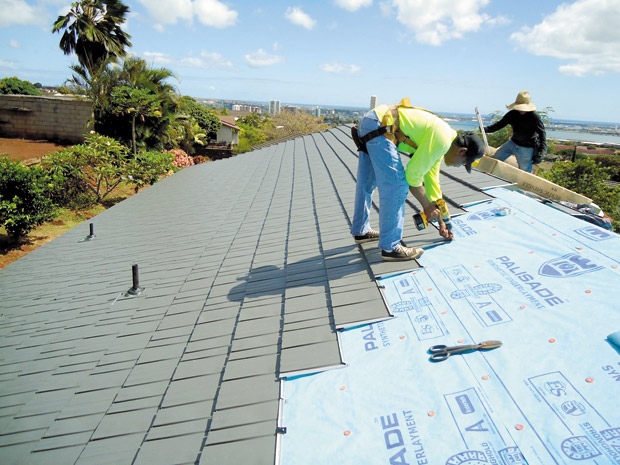The art of keeping your house cool is not just one quick fix, especially during the extreme summer heat. Achievement comes from merging various strategies that will keep you calmer while also saving you money. A cool roof is among the best ways to keep a lower surface temperature on sunny days.
A cool roof design reflects more sunlight and absorbs less heat. Almost any type of building can benefit from a cool roof. This guide helps you learn about the best ways to cool down a roof during hot days.
To speak to a professional about your roofing needs, contact Lubbock roofing companies.

How to Keep Your Roof Cool
The heat absorbed by roofs during sunny days can easily increase your building’s temperatures. This leads to higher air conditioning requirements and energy costs. Luckily, you can tackle this challenge in various ways and cool down your roof.
●Insulate Your Attic
Irrespective of the quality of your shingles, some heat is always transmitted into your house. Insulating your attic is among the cheapest ways to avert temperature deviations and moisture damage not only during summer but also in winter.
Insulation is an ideal way of dropping your energy expenses. It is simple and easy to do on your own.
● Grow a Roof Garden
One of the finest ways to keep your roof cool is by growing a rooftop garden using tinned plants and green grass. The green guards your house against direct sunshine while the mud inside the potted plants and the lawns absorb most of the heat that hits the roof.
Before opting for a roof garden, ensure that your roof is waterproof to thwart any water from leaking through the external walls or roof slab, causing damage to your house.
● Roof Mist Cooling System
A roof mist cooling system allows you to enjoy the benefits of a cool roof without extra new surface materials or coating. The system works through sensors to measure roof temperatures and moisture. It then sprays a smaller amount of water across the roof, letting the water cool your roof as it evaporates.
Though the mist cooling systems work better on commercial roofs, it is possible to use them on residential applications depending on your roofing materials.
● Insulate Your Roof with Spray Foam
Using a spray polyurethane insulating foam is among the best ways to cool your roof. Commonly known as SPF, the foam act as a hurdle to inhibit seepages and fluctuating temperatures in your current roofing system.
Apart from cooling effects, other benefits that come with using the spray foam include the following.
- Decreases the likelihood of destruction to your house since it strengthens the structure.
- It guards your home against the entry of pests.
- It upsurges the resistance of your building against wind uplifts.
● Plant Trees or Shrubs
Planting trees or shrubs around your home keeps the place shaded from the sun and other weather. Always be cautious about planting the trees too close to the house. Nevertheless, please consult an expert before you plant the trees to advise how far they should be from your house.
Trees and shrubs also act as windbreakers in winter to help protect the house from cold air. Also, it is important to spend in a gutter guard system since leaves, and other debris will amass faster than normal.
●Paint The Terrace White
It is possible to reduce heat by turning your roof into a reflective roof surface. You can achieve this by painting the concrete floor using cool roof paints. The paints offer good thermal insulation by reflecting the sun rays and keeping the indoors cool.
● Metal Roofing
Metal roofs without paint are naturally reflective, but they hold heat, making them ideal for steep roofs. Additionally, a factory-applied coating improves the metal roof’s releasing properties. This makes some metal roofs meet the requirements of a cool roof.
● Wind Catchers
Wind catchers on the roof direct cool air down. A windcatcher is mostly used in nations with hot, dry climates. The device comes with an onion-shaped vault with nearly vertical vanes that turns upon a slight breeze.
The blades force cool air down a shaft into your building. A vent seal at the lower part of the windcatcher can be closed and sealed in cool weather to prevent cold air entry.
Advantages of Cooling Down Your Roof
Just like any other project, one takes, working on cooling down your roof comes with its share of merits. Here is how you are likely going to benefit after cooling down your roof.
● Low Energy Costs
The most obvious benefit of having a cool roof is energy saving. When less heat gets transferred into your house from your roof, the cooler your home will be, and less you will have to run your AC system.
● A Long-lasting Roof
Degradation occurs once a roof gets exposed to heat over a long period. This is more likely to happen on asphalt shingles when under direct sun exposure. However, making sure that your roof is always cool during sunny days makes it last longer. Therefore, you will not have to keep on replacing the roofing materials.
●Better Indoor Comfort
Some places can be very tight and get uncomfortable during hot seasons. However, working on how to make the structure’s roof cool improves your comfort. You will be able to go about your daily activities without a hassle, specifically during hot summer.
●Sustainability
Using less energy to cool your house minimizes your power consumption. This reduces the demand for power generation, assisting in preserving natural resources for other uses. This translates to fewer greenhouse gas emissions.
Final Word
Keeping your building cool may cost you lots of dollars annually. Also, air conditioners, ice makers, and ceiling fans consume a lot of energy in making the average temperature of your house cooler. However, you have learned that having a cool roof keeps your energy bills low and makes your house interiors conducive during sunny days.



